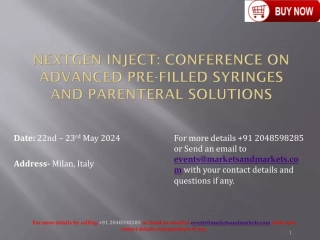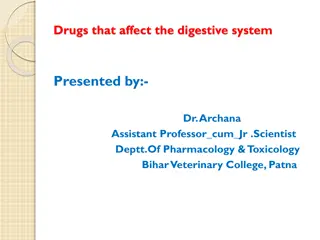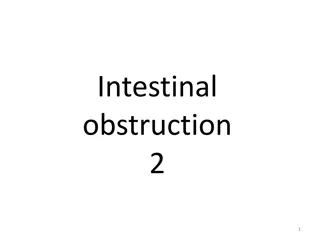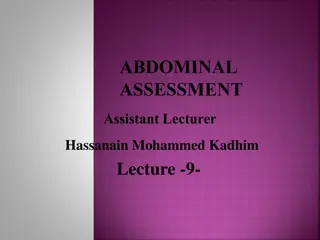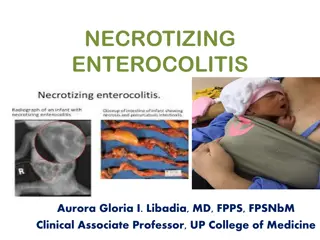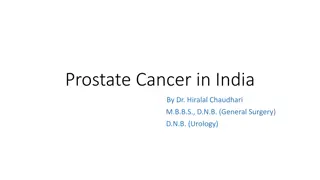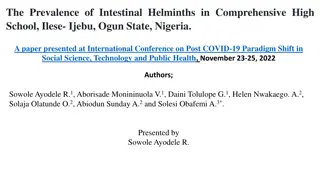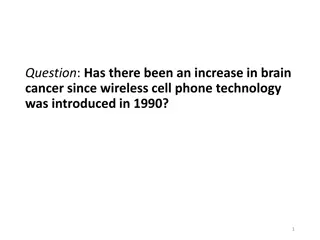Parenteral Nutrition in Intestinal Failure Related to Advanced Abdominal Cancer
Discussion on parenteral nutrition in patients with intestinal failure secondary to advanced abdominal cancer, including considerations for patient selection, Christie referral pathway, and practicalities of home parenteral nutrition. The background highlights the increasing commonality of home parenteral nutrition in advanced malignancy cases and causes of intestinal failure in this patient group.
Download Presentation

Please find below an Image/Link to download the presentation.
The content on the website is provided AS IS for your information and personal use only. It may not be sold, licensed, or shared on other websites without obtaining consent from the author.If you encounter any issues during the download, it is possible that the publisher has removed the file from their server.
You are allowed to download the files provided on this website for personal or commercial use, subject to the condition that they are used lawfully. All files are the property of their respective owners.
The content on the website is provided AS IS for your information and personal use only. It may not be sold, licensed, or shared on other websites without obtaining consent from the author.
E N D
Presentation Transcript
The decision to start HPN: Patient selection and considerations Bethany Miller Clinical Fellow in Intestinal Failure Salford Royal Hospital
Aims Discuss parenteral nutrition (PN) in intestinal failure related to advanced abdominal cancer Christie referral pathway for HPN Review some of the practicalities involved for patients receiving HPN Not covering PN in cancer cachexia
Background Home Parenteral Nutrition (HPN) in advanced malignancy is becoming increasingly common 2005 2006 2007 2008 2009 2010 2011 2012 2013 2014 2015 Total n= 112 n= 101 n= 138 n= 157 n= 148 n= 228 n= 262 n= 351 n= 472 n= 400 n= 420 Malignancy 13 17 16 24 14 32 43 66 116 102 115 New adult HPN registrations, 2005 and 2015 Lack of consensus throughout the world, with the proportion of HPN patients with cancer as the indication up to 60% in some parts of Europe (Naghibi et al, 2014) BANS report on Adult Home Parenteral Nutrition & Home Intravenous Fluids, 2016
IFU SRFT - referrals Year Total referrals to IFU Total referrals for remote D 2009 10 147 2010 11 121 2011 12 126 2012 13 152 13 2013 14 156 7 2014 - 15 146 16 15 - 16 171 15 16 - 17 180 32 17 - 18 195 43 18 - 19 198 57
Primary malignancy Gastro-intestinal n=16 Gynaecology n=29 other n=13 pseudomyxoma n=5 Others: - Lymphoma - Mesothelioma - Pancreatic - Carcinoid - Urology
Background Failure to maintain weight and nutrition is common in patients with cancer In those with a functioning and accessible GI tract, use oral/enteral route of nutrition In those with intestinal failure secondary to advanced abdominal malignancy (e.g. inoperable malignant bowel obstruction) consider parenteral nutrition
Background Causes of IF in this group Malignant bowel obstruction (partial, intermittent, complete) Enterocutaneous fistula Short bowel from surgery Dysmotility Severe mucosal disease (radiation, chemotherapy)
Patient selection What are the current guidelines and recommendations?
NICE 2017 HCPs should consider parenteral nutrition in people who are malnourished or at risk of malnutrition, with either: Inadequate or unsafe oral and/or enteral nutritional intake a non-functional, inaccessible or perforated gastrointestinal tract.
ESPEN 2016 ESPEN guidelines recommend taking into account: Expected survival Benefits of potential cancer treatments Nutritional status Potential effects of artificial nutrition Performance status Wishes of the patient and close relatives
BIFA position statement (2017) Better QoL and survival if : Higher performance status i.e WHO performance status 2/ KPS >50 (ideally 70) Low serum markers of inflammation (CRP <10 mg/L and albumin >30 g/L) Patients with an expected prognosis of 2-3 months or greater Thoughts on this? Plan made for withdrawal at end of life
Other positions parenteral nutrition may play a role in incurable cancer if patients are expected to die earlier from starvation than from tumour progression We recommend offering and implementing nutritional interventions in patients with advanced cancer only after considering together with the patient the prognosis of the malignant disease and both the expected benefit on quality of life and potentially survival as well as the burden associated with nutritional care *Curr Opin Support Palliat Care. 2007 Dec;1(4) Total parenteral nutrition in cancer patients. Bozzetti F1 ESPEN 2017
Palliative Classification P1 IF Expected short survival (< 12 weeks) Good performance status Low inflammatory markers rapid discharge home with objective measureable goals P2 IF PN whilst on-going treatment (e.g. chemo/debulking surgery) May P1 or P3 Often metabolically unstable May require more intensive monitoring May require management from multiple specialties P3 IF Slow growing tumours (e.g. ovarian, pseudomyxoma, NET, sarcoma) Expected survival years BAPEN 2018
What are we trying to achieve? Cochrane review 2018 13 observational studies with 721 participants >70% had malignant bowel obstruction (54% GI cancer, 33% gynaecological On home parenteral nutrition Differing definitions of survival. Median survival 15-155 days QoL assessments equivocal We are very uncertain whether HPN improves survival or quality of life in people with MBO as the certainty of evidence was very low for both outcomes Sowerbutts et al, 2018
Other reviews Systematic review1 Median survival: 15 140 days 45% with MBO survived to 3 months Higher Karnofsky Performance Status had longer survival Multi-centre prospective case series2 50% mortality 3 months 77% mortality at 6 months 1Naghibi, Smith, Elia, 2014 2Bozzetti et al, 2014
Considerations Patients should be informed that this is a potential treatment option Early MDT and referral to HPN centre Plan for withdrawal should be in place
Multi-disciplinary team approach All considerations supported by a multi- professional team Nutrition Dietician, nutrition nurse, pharmacist, gastroenterologist Oncology Palliative care Psychology Surgeons (if appropriate)
Risks vs Benefits Risks Disrupted sleep Tied to visits from Home Care nurses Line complications (infection/thrombosis) HPN complications e.g. metabolic Benefits Time Bridge to surgery or further cancer treatment Personal goals Putting affairs in order
Other considerations Other adjuvant treatments Surgical assessment to see if surgical resolution to bowel obstruction Consider venting gastrostomy Need for a long-term line and complications that may be associated with this
Remote discharge A pathway between SRFT team and The Christie to aid a safe and rapid discharge of patients requiring discharge on palliative PN.
Remote discharge The mean number of days between receipt of referral by the IFU to discharge on HPN from The Christie was 10.1 days (now shorter). Following remote discharge, the mean number of days on HPN was 215.9 days. Catheter-related blood stream infection rates were very low at 0.169 per 1000 catheter days. Bond et al 2019
How to start Patients need assessment by the multi- disciplinary team
Any patient for HPN must be referred to Salford IFU Christie pharmacist to communicate with IFU pharmacist IFU referral form fully complete with covering letter and returned to IFU IFU team to assess patient: - OP setting - On ward by HCC nurses - Transfer to IFU
Remote discharge SRFT team Review fluid balance chart and up-to-date bloods If CVC in place, review tip position on CXR Assess ongoing PN Make final script for PN Written communication to referring team with detailed plan Find suitable HCC and liaise with HCC to arrange CVC care/training Arrange TPN prescription with HCC
Remote discharge Christie team Provide details of contact person who provides discharge planning Provide accurate and up-to-date fluid balance, blood results, PN script, relevant medical details, CXR Allow access of HCC to the ward Ensure suitable single-lumen dedicated central line in-situ Update SRFT with changes in circumstances
Remote discharge HCC Review patient at The Christie Provide information to SRFT regarding possibility of remote discharge Home assessment Assess feasibility of HPN under the individual circumstances
Installation of equipment Need to store: pump, fridge, drip stand and trolley Supplies Date confirmed Communicated to patient and NOK Communicated to ward and discharge coordinators.
Remote discharge Following discharge Patient monitored regarding HPN under the SRFT team, either OPD Or by HCC nurses at patient s bedside
HPN practicalities At around 5pm every day, I have to set up my Total Parenteral Nutrition, or TPN. This is a form of artificial feeding via a central line into a vein. It takes about half an hour to set up, using an aseptic technique, which requires great care. The actual feeding takes twelve hours over night. The photograph shows the bag of nutrition, an infusion pump, and the dressing pack.
Questions you may be asked Can I still eat? How does it go into me? Is it every night Who looks after my line? Do I really need it?
Equipment and deliveries Equipment: pump, fridge, drip stand and trolley PN delivered every 2/52 Consumables every 4/52: PN feed and flushes Ancillaries/Consumables: dressing packs, towels, gloves, cleaning solution, needles, syringes etc
Day-to-day practicalities once home Generally infused overnight for 12 hours. Sleep disturbed Toilet breaks Noise from pump Restricted Home care companies provide connection and disconnection time slots Family and patients can be trained
Webinar: PN in palliative oncology Monday 24th Feb Webinar 1 - https://register.gotowebinar.com/register/39 24333326082166285 Webinar 2 - https://register.gotowebinar.com/register/86 8282538188512269
Thank you Any questions?


